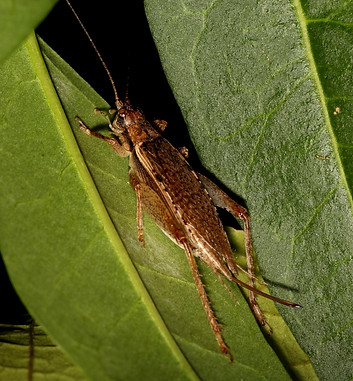Jumping Bush Cricket

Jumping Bush Cricket (Orocharis saltator)
Occurrence
Very common in most of our area, but still absent or unusual in parts of the snow belt. They are abundant in the counties south of Cleveland.
Habitat
Shrubs and trees. They're becoming an expected species in urban as well as rural areas, and woods south of Cleveland can be filled with their songs. They are absolutely abundant in Cleveland’s University Circle.
Range
Steadily moving northward and now up to Lake Erie in many locations. They are in all counties of our region, but distribution is still spotty in Geauga County and inland Lake County
Physical description
They blend beautifully with the twigs, branches and trees trunks from which they sing. They're the color of wood and their flat relatively flat body shape allows them to keep their body profile against the bark.

Song
A continuous series of beautiful, leisurely chirps with a brief pause between each one. When temperatures are chilly, it’s possible to hear all the individual wing strokes that make up each chirp. They sing at night, but will also sing in the late afternoon as fall progresses.
The recording below has two consecutive singers, and the first is a little warmer than the second. Although it's not dramatic, can you detect a difference between them in pitch and speed?

Now listen to Jumping Bush Crickets at 55F.
When they're cold, their songs slow down enough that you may be able to hear the individual wing strokes that make up each song (see the sonogram illustration below). When it's a very warm night, the songs are much more rapid and sound like a single chirp.

General description and context
Males run and jump along a branch, stop, pop up their wings, sing, lower their wings, run and jump some more, pop up their wings and sing again…all the while the females evaluate the performance. In addition to their wood-like coloration, their frequent movement increases the difficulty in locating the singers.


You will likely see the nymphs as well - look for them on as well as trellises, arbors, boardwalk railings, and park benches, where they will be obvious. They are as active as the adults. Remember that nymphs have either no wings yet or just small wing buds.

These crickets were not in the Cleveland area when I was growing up or even as a younger adult. I was delighted the first time I heard one or two on a nearby street in my neighborhood and even more thrilled when the first one arrived in our backyard. Now, the entire area, like so many other neighborhoods, is filled with their jingling trills.
Similar species
None in our area. The Restless Bush Cricket does not sing and is not found this far north in Ohio.
Field and suburban observations
I have heard Jumping Bush Crickets singing in potted trees for sale in the Home Depot parking lot; they likely were moved with the trees. They are also on Kelleys Island and I suspect they came over on the ferry in landscaping trees and shrubs. Here at home, I discovered a mating pair on the side of the garage one evening.

Listening in Nature posts:
http://listeninginnature.blogspot.com/2017/12/the-odd-ones.html
http://listeninginnature.blogspot.com/2014/10/jumping-beyond-range-map.html
Songs of Insects:
http://songsofinsects.com/crickets/jumping-bush-cricket
Singing Insects of North America:
